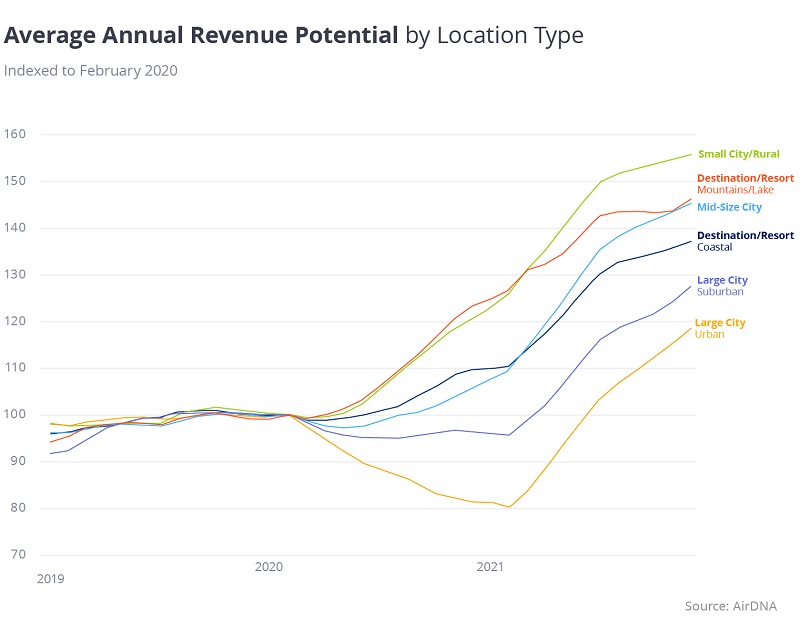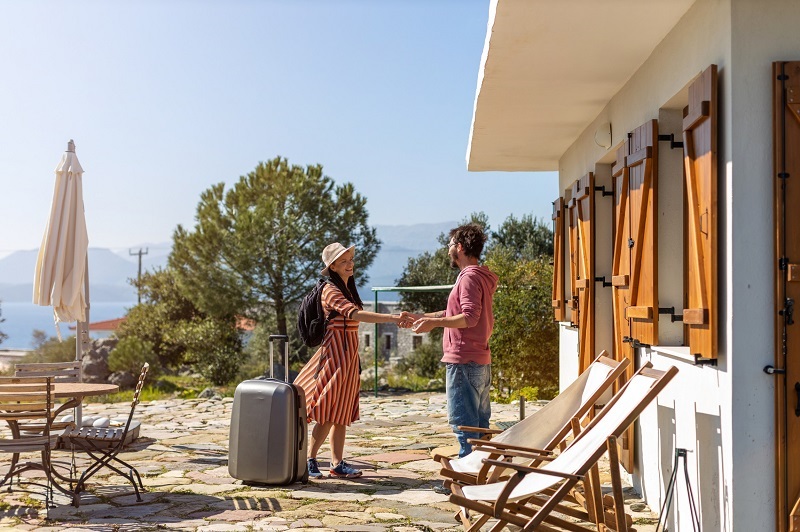A vacation home is defined as a secondary dwelling that’s primarily used for recreational activities like vacations, holidays and retreats, rather than a permanent primary residence. In recent years, short-term rentals have become a lucrative business for owners of vacation homes around the world, with demand increasing even more of late.
As cited by AirDNA, short-term rentals occupancy rates in the United States have risen by 10% since 2019. Compared to years prior to that marker year, short-term rentals are now earning 39% more annually on average. If you are an owner of a vacation property, these numbers might entice you to turn your secondary home into a rental property.
However, before pursuing this potentially lucrative opportunity, be sure to consider upfront the mortgage, insurance, tax, maintenance costs, and other implications of renting out your property. All of these matters can be sources of stress and recurring headaches, if you do not properly research and plan.
To help you out, here’s a deep dive into how you can successfully turn a vacation home into a rental property.
Table of Contents
- Assessing the Rental Potential of Your Vacation Home
- Preparing Your Property for Renting
- Marketing Your Short-Term Rental Property
- Managing Your Short-Term Rental Property
- What If You Don’t Have a Vacation Home?
- Closing Thoughts
Also see:
Assessing the Rental Potential of Your Vacation Home
- Determine If Your Location is Friendly to Short-Term Rentals
- Identify Your Target Audience
- Don’t List Your Property Until Running Cost Calculations
Determine If Your Location is Friendly to Short-Term Rentals
Not every market is suitable for short-term rentals due to strict regulations, which could make it challenging to rent out your house. So, you will need to find a market that is amenable to owners of investment properties and conducive to your specific plans that is also resistant to economic downturns.
Turning a vacation house into a rental property in rural areas can also be promising. That is because there is a scarcity of apartments in the hottest rental markets. As per AirDNA’s 2021 market report, the following types of locations have been the most profitable for short-term rental owners:
- Rural Locations
- Small Cities
- Mountainous Areas
- Lake-Side Destinations

Image courtesy of AirDNA
If you have a vacation home in places like Hyannis, San Simeon, Winnetka, Saranac Lake, or Dale, you can easily turn it into a rental property. We especially like to mention Sleepy Hollow, New York to use a vacation home as a rental property. With a median list price of $1,119,995 and an average price per square foot of $709.77, buying and renting out a property in Sleepy Hollow can be a good deal. Additionally, it is close to the Tarrytown or Phillips Manor trains, which is another key point for renting a home.
Even if your vacation home is not in an area that permits short-term rentals, you may still want to consider turning it into a long-term rental as the market for rental property remains hot in many parts of the US.
At the start of 2023, RentCafe conducted market analysis of 134 popular rental markets in the US. The analysis shows that it takes a maximum of just 38 days to occupy most vacant apartments. The study also suggests that tenants are facing intense competition in areas that were not competitive in 2022. These areas include Miami, Orlando, and the Southwest part of Florida.
Demand for rental properties has also significantly increased year-over-year in Pennsylvania, Illinois, Missouri, Massachusetts, and California. Among these places, New Jersey has turned into the most desired place to rent vacation apartments. This locations has experienced increases in rental income from 75% to 151% between 2015 and 2020.
Also see:
Identify Your Target Audience
Identifying your target audience is a vital part of turning your secondary home into a prosperous rental property. If you find other comparable vacation rentals in your area, you can use them to determine what your audience is looking for and tailor your rental offering accordingly.
Understanding who your ideal customer is and their preferences will also inform your marketing programs such that you can clearly communicate that your property has what target vacationers are seeking.
Don’t List Your Property Until Running Cost Calculations
Don’t list your rental property until you go through several iterations of cost and profit calculations. To do this exercise create a list of every existing expense you have for your vacation home, such as your mortgage payment, utilities, property taxes, and repair costs, community dues, and property management fees.
Also, include any repairs, maintenance, and other spending that you will have to do after your property is rented out. Once you have a clear idea of your expenses, determine how much profit you desire to earn each month. This will help you set a rental rate that meets your financial goals.
To ensure that your rate is competitive, see other rental properties in the same area and see what they charge for a vacation house similar to yours. This will give your concrete ideas on features that will enable you to attract tenants at your preferred rental rate.
Preparing Your Property for Renting
- Be Aware of Local Regulations for Vacation Rentals
- Obtain All Necessary Permits and Licenses
- Get Your Home Ready Inside and Out
- Make Your Home Attractive to Tenants
- Provide All Essential Amenities
Be Aware of Local Regulations for Vacation Rentals
It is crucial to confirm that you are able to rent out the home legally as a rental property before listing it. Local rules governing vacation rentals vary in different cities, counties, and states. So, research the local regulations in your area to avoid any legal issues.
Cities can also have different rental rules and laws within specific zones or districts, as well as building types.
Obtain All Necessary Permits and Licenses
Remember to check with your homeowner’s association (HOA) for any restrictions that can be applied to your rental property. The homeowner’s association could prohibit you from renting out the house, and you could face heavy fines if you violate their rules. In addition, you may need to obtain a rental license and pay additional taxes on your rental income per local rules.
Get Your Home Ready Inside and Out
Your house has to be appealing to the types of tenants you wish to attract. To do that, you will likely need to conduct some repairs and upgrades. Just like when selling a property, it is essential to make it desirable and marketable to your potential tenants. The most affordable and easiest thing to do is ensuring that your rental property is clean and freshly painted.

If some areas of your property look old-fashioned or outdated, consider replacing them. It can be replacing the faucets in the kitchen and bathrooms or the handles and knobs on your kitchen cabinets.
Nevertheless, keep in mind that the cost of any upgrades should not exceed your budget. Ignoring maintenance problems can cause you negative reviews, so be sure to address any issues like this. Remember, you will need to incorporate the cost of these upgrades and repairs into your rental rates. Therefore, do not go overboard and spend wisely.
Also see:
Make Your Home Attractive to Tenants
Design can influence your audience to rent your house. It can also dictate how much money you can earn through rent. Short-term rental guests nowadays frequently choose a home with a chic and appealing interior over properties that have outdated décor and furniture.

So, it’s important to furnish and decorate your property accordingly. A great appeal of short-term vacation rentals found on sites like Airbnb is that vacationers can have a more luxurious and enjoyable experience than what they could find in a typical hotel for the same cost.
The design and décor of your rental home is another example of understanding the preferences of your ideal target tenants. For example, some customer segments may be looking for a once-in-a-lifetime luxurious experience that would warrant paying higher rates for a property with modern amenities and high-end details.
Provide All Essential Amenities
Furthermore, the home needs to have unique features and all necessary amenities that will make it attractive to your targeted audiences.

Another important category of tenants to consider is large, active families who are willing to pay a premium for a property that has lots to offer such that it makes packing and travel logistics low-stress and easy. For this tenant scenario, think of safe and flexible layouts with lots of recreational equipment and entertainment supplies that minimize the need to bring extraneous items.
Marketing Your Short-Term Rental Property
- Create a Website for Your Property
- List Your Vacation Rental on Key Websites
- Test Other Channels to Advertise Your Vacation Rental
- Invest in Social Media Platforms
Create a Website for Your Property
To market your rental property effectively, you should plan to create a website for it. A well-designed website with relevant, helpful and up-to-date information will be indexed by Google and then discoverable by vacationers looking for what your property offers.
There are many affordable solutions for creating a vacation rental website. You can either look to incorporate rental templates and booking functionality with broad, well-established website platforms, such as: Wix, Squarespace, or WordPress.
Another approach to consider taking is working with a specialty vendor that is focused solely on websites for rental properties, such as: Lodgify, Hostaway, Tokeet, OwnerRez, or Smoobu.
List Your Vacation Rental on Key Websites
You can also list your rental property on various sites so that renters can find it easily. Airbnb, Booking.com, VRBO, and TripAdvisor are some popular options for vacation rental websites.

If you are struggling to find people to rent your property, also try alternative sites, such as Cottages.com and American Snowbird to increase visibility. The more places your property is listed, the easier it will be for renters to discover it and book it.
Test Other Channels to Advertise Your Vacation Rental
You can advertise your rental property through many other channels, including Google, real estate agents, newspapers, etc.
As you get more familiar with your target audience and what they are looking for, you can advertise on Google to have your text ads show for specific search queries that are most relevant to the unique benefits and features of your property.
Whenever you are in the presence of vacationers, especially in your rental market, try to strike up a causal conversation to learn how they discovered their rental property and why they decided to book it. This can lead to discovering new partnerships (e.g. trusted local real estate agents) or lesser-known websites that locals use.
Invest in Social Media Platforms
Also, social media platforms such as Facebook, Instagram, and Twitter can play a critical role in advertising your rental property. Create posts and share photos of your rental property on these platforms and ask your followers to help you spread the news. Also consider giving incentives for renters to share their experience on their preferred social platforms, as well.
Managing Your Short-Term Rental Property
- Create Proper Rental Policies and Procedures
- Carefully Screen and Select Your Renters
- Hire a Rental Manager
Create Proper Rental Policies and Procedures
Along with clearly communicating your rental rate, you should let your tenants know the policies and procedures for the rental use of your home in writing. This should cover things like how many guests are allowed, the policy on pets, where to put the garbage, any cleaning requirements, whether smoking is allowed, and what to do in case of damages.
You can find online policies and procedures that you can customize to your needs, or you can seek the assistance of a rental manager to help you create one that fits your unique property and requirements perfectly.
Carefully Screen and Select Your Renters
Renting out your house to strangers can be an intimidating and nerve-wracking experience. But you can ease some of your worries by establishing a protocol for screening potential tenants. It will help you determine whether or not someone is a good tenant for your rental property. Also be sure to follow local laws when screening applicants.
Also see:
Hire a Rental Manager
As a rental property owner, you should learn how to manage your rental effectively. After all, you want your tenants to enjoy their stay so that they will want to come back again and refer your property to friends and family. Besides doing the above-mentioned items, you also have to do several other critical tasks to manage your rental property effectively.

These responsibilities include:
- Setting up a payment and booking system
- Maintaining the rental property and handling repairs
- Handling legal and financial aspects of renting property
You can do all the above things by yourself or appoint a rental manager to do these tasks. Although managing your rental properties yourself can save you money, it requires a significant investment of time, effort, and personal skills.
If you already have a lot of work to do in your daily life, taking on these additional responsibilities can become quite stressful and challenging. So, consider the costs and workload carefully and then decide whether to hire a rental manager or to handle the management by yourself.
Also see:
What If You Don’t Have a Vacation Home?
Though many existing and aspiring homeowners may view having a vacation home as an unrealistic dream, don’t give up so easily. When thinking of a vacation home as a source of rental income, the options are definitely more plentiful and feasible than you may realize.
These scenarios further underscore the value of purchasing more land than you may currently need, whether part of your permanent residence or a discrete parcel in another location. Owning landing within a jurisdiction with flexible usage criteria can be quite valuable in every sense of the word.
Here are a few creative approaches to owning a vacation property worth considering:
- Turn Your Existing Home into a Rental Property
- Add an ADU to Your Backyard
- Buy an Affordable Piece of Recreational Land
- Convert an Inherited Property into Rental Property
- Purchase a Condominium in an Emerging Tourist Destination
Also see:
Turn Your Existing Home into a Rental Property
If you are currently in a home that is not adequately meeting the collective needs of your family, but you are hesitant to sell in a slowing market, turn it into an investment property. Whether converting your home into a short-term or long-term rental, this option can buy you valuable time for the market to rebound before attempting to sell again. The rental approach is also helpful when needing to relocate sooner than expected.

Also see:
Add an ADU to Your Backyard
With a growing number of local jurisdictions encouraging homeowners to add ADUs to their properties (both attached and detached) to increase rental housing supply, this is a highly flexible option to consider. In tandem with the growing popularity of short-term rentals, you may be able to start your vacation home search by simply looking in your backyard. Be sure to learn about innovative prefab ADU companies in the process.

However, be extra careful to investigate current local short-term policies and restrictions pertaining to ADUs and in-law apartments. Perceptions both pro and con towards ADUs in residential areas continues to be a hot topic among homeowners and local governing bodies.
Also see:
Buy an Affordable Piece of Recreational Land
Owning land is another “dream” that many existing and aspiring homeowners may never consider. We especially encourage young aspiring homeowners to look toward buying land first, as an affordable way to combat rising real estate values. With innovations in affordable construction proliferating and increasing ways to monetize one’s land and property, keep an eye on this area of opportunity. Remote work further opens up creative options for purchasing land when many workers can literally live anywhere.

In the case of land, you may not even need to have a vacation property, as it is possible to monetize your land by leasing it for recreational usage, such as: camping; fishing; hunting; and special events.
Also see:
Convert an Inherited Property into Rental Property
When adult siblings inherit their parent’s home, they often prefer to sell for a quick financial settlement to disperse the proceeds equitably. However, turning the property into a vacation rental is an option worth consideration. The rental approach can help subsidize the cost of on-going upgrades, while creating options (i.e. buying times) for family members to move-in permanently at a more convenient time.

Also see:
Purchase a Condominium in an Emerging Tourist Destination
Owning a condominium is another viable option in a tourist destination that is not as well-known as it will be in coming years. The benefit of owning a rental property in a tourist location is that the local government is typically very supportive of businesses serving the local and prosperous tourist industry. Another attractive benefit is that there is consistently high-demand for vacation rentals.

Also see:
Closing Thoughts
Owning rental property can be an excellent way to achieve financial success. However, turning your vacation home into a rental property can be daunting at first. We have all heard horror stories of landlords facing more problems than profits. But with a bit of patience, research, and the right professional guidance, you can successfully convert your vacation house into a rental property.

Transforming your property from a personal one to a rental property is just the beginning. To attract audiences, generate revenue, and stand out from competitors, you will also need to be strategic and organized. If you thoroughly investigate the topics in this article before ever welcoming your first tenant, you will likely become a successful vacation rental property owner.
More Recommended Real Estate Reading
- These Features Will Make Your ADU More Desirable & Valuable
- 10 Creative Ways to Monetize Your Home
- Researching a Neighborhood: Frequently Asked Questions
- What is a Turnkey Home in Today’s Market?
- Homebuyer Beware: The Perils of Flipped Homes
- What to Consider When Purchasing an Older or Historic Home
| Purgula is reader-supported. When you click on links to other sites from our website, we may earn affiliate commissions, at no cost to you. If you find our content to be helpful, this is an easy way for you to support our mission. Thanks! Learn more. |







